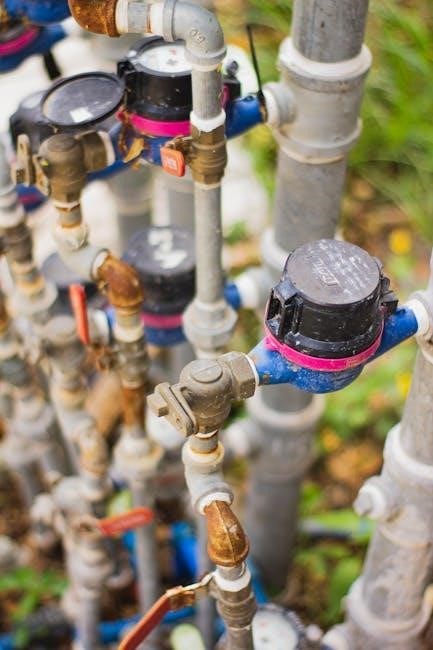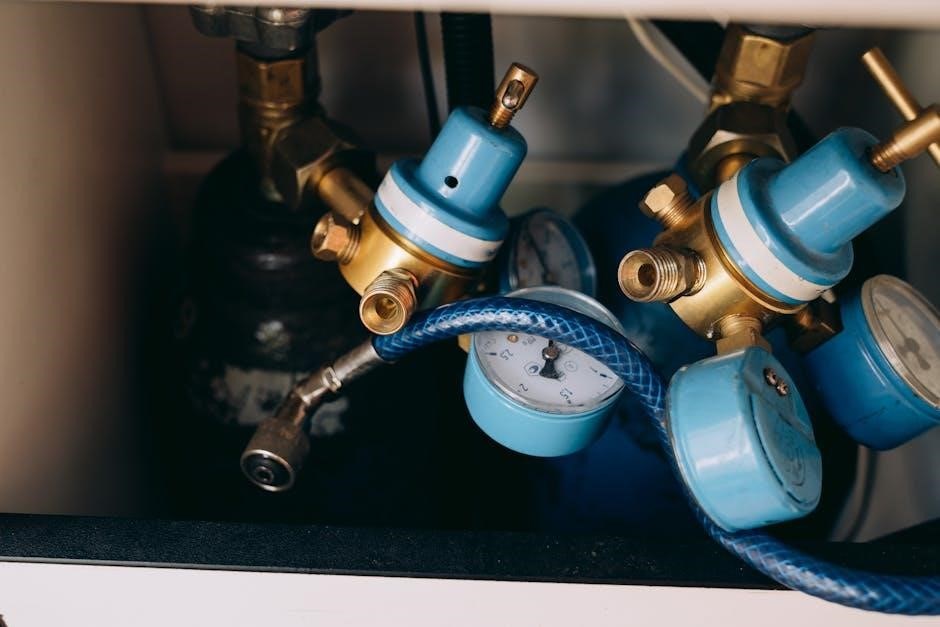P&ID symbols represent piping, instrumentation, and control elements in process plants. These standardized graphical elements ensure clarity, safety, and efficiency in plant design and operation.
Overview of P&ID Symbols
P&ID symbols are standardized graphical representations used to depict piping, instrumentation, and control systems in process plants. These symbols are essential for understanding the layout and operation of industrial processes. They include notations for pipes, valves, instruments, and equipment, ensuring clarity and consistency across designs. Common symbols represent components like pumps, tanks, heat exchangers, and control valves. Standardization, often guided by ISA S5.1, ensures universal understanding, facilitating communication among engineers and operators. These symbols are crucial for designing, operating, and maintaining facilities in industries such as oil refineries, chemical plants, and power generation. Free resources and PDF downloads are widely available, offering detailed libraries for project use.
Importance of Standardization in P&ID Symbols
Standardization in P&ID symbols ensures universal understanding and consistency across industries. It eliminates ambiguity, reducing errors in design and operation. Organizations like ISA (Instrumentation, Systems, and Automation Society) set standards, such as ISA S5.1, to unify symbol representations. This standardization is critical for safety, as it helps engineers and operators interpret diagrams accurately. Without it, misunderstandings could lead to operational hazards. Standardized symbols also facilitate compliance with regulatory requirements and industry best practices. They enable efficient communication among teams, enhancing collaboration and reducing downtime. Ultimately, standardized P&ID symbols are essential for maintaining clarity, safety, and efficiency in process plant operations, ensuring reliable and consistent documentation.

Basic Components of P&ID Symbols
P&ID symbols include representations for piping, valves, instruments, and control elements. They are categorized into mechanical, electrical, and digital components, ensuring clear process visualization and documentation.
Piping and Fittings Symbols
Piping and fittings symbols are essential for representing pipes, flanges, valves, and other components in P&IDs. Common symbols include flanges, tees, elbows, and reducers, which are standardized to ensure consistency. These symbols depict how pipes are connected and routed within a system. They are crucial for understanding the physical layout and material flow in process plants. Proper use of these symbols ensures clarity in design, maintenance, and operation. Standardized piping symbols also help in identifying components like orifice plates and strainers, which are vital for process control and safety. These symbols are widely used across industries, including oil, gas, and chemical plants, to maintain uniformity and readability in P&IDs.
Instrumentation and Control Symbols
Instrumentation and control symbols are vital for representing measurement and control devices in P&IDs. These symbols, such as pressure gauges, temperature transmitters, and control valves, are standardized to ensure universal understanding. They depict how instruments interact with the process, including sensors, actuators, and controllers. Symbols for loops and interlocks provide detailed insights into control logic. Proper use of these symbols ensures accurate communication of process automation and safety systems. They are essential for engineers to design, operate, and maintain process plants efficiently. Compliance with standards like ISA S5.1 ensures consistency, making these symbols invaluable for troubleshooting and modifications in industrial settings.
Valves and Actuators Symbols
Valves and actuators symbols are crucial in P&IDs for representing flow control devices. These symbols depict various valve types, such as gate, globe, ball, and butterfly valves. Actuator symbols indicate the valve’s operation method, including pneumatic, hydraulic, or electrical control. Symbols for positioners and quick-exhaust valves provide additional operational details. Standardization ensures clarity across industries, with ISA S5.1 guiding their representation. These symbols are essential for understanding process control, safety systems, and emergency shutdown mechanisms. Accurate depiction of valves and actuators ensures reliable plant operation, maintenance, and troubleshooting, making them indispensable in P&ID documentation for process industries.

Process Flow Diagrams (PFD) and P&ID
Process Flow Diagrams (PFD) and P&IDs are essential tools in process design. PFDs provide a simplified overview of the main process flow, while P&IDs offer detailed piping, instrumentation, and control representations, ensuring clarity and precision in plant operations and design.
Evolution from PFD to P&ID
The evolution from Process Flow Diagrams (PFD) to Piping and Instrumentation Diagrams (P&ID) marks a progression from simplicity to complexity. A PFD is the first document developed, providing a high-level overview of the process flow, including major equipment and material streams. As the design advances, the PFD is expanded into a P&ID, which adds detailed piping, instrumentation, and control systems. This step-by-step development ensures that the process is clearly understood and systematically designed. The use of standardized symbols in both diagrams ensures consistency and clarity, making them essential tools for engineers and operators in understanding and managing process systems effectively.
Key Differences Between PFD and P&ID
The Process Flow Diagram (PFD) and Piping and Instrumentation Diagram (P&ID) serve distinct purposes in process design. A PFD provides a simplified overview of the process, highlighting major equipment, material flows, and key controls. It lacks detailed piping and instrumentation specifics. In contrast, a P&ID offers a detailed representation of the entire system, including piping layouts, valves, instruments, and control loops. The level of detail in a P&ID is significantly higher, making it essential for construction and operation. While the PFD is used for initial planning and understanding, the P&ID is crucial for precise engineering and maintenance activities, ensuring clarity and safety in complex process systems.

ISA Standard S5.1 for Instrumentation Symbols
ISA Standard S5.1 provides guidelines for uniform symbols in instrumentation and control. It ensures consistency across industries, aiding engineers in creating clear, universal P&ID designs for process plants.
Standardized Symbols for Instruments and Valves
Standardized symbols for instruments and valves are essential for maintaining consistency in P&IDs. These symbols, as per ISA S5.1, represent components like pressure gauges, control valves, and actuators. Each symbol is designed to be universally understood, ensuring clear communication across teams. Instruments are often depicted within circles, with functional identifiers at the top and loop identifiers at the bottom. Valves are shown with specific notations indicating their type, such as globe, gate, or ball valves, and their actuation methods, like solenoid or pneumatic. This standardization minimizes ambiguity, enhances safety, and streamlines both design and operational processes in industrial plants. Regular updates ensure relevance to evolving technologies and practices.

Loop Diagrams and Their Significance
Loop diagrams are detailed representations of control loops, illustrating all components and their interconnections. They are crucial for understanding process control systems, as they depict how instruments, valves, and actuators interact. These diagrams often include standardized symbols for clarity, adhering to ISA S5.1, and are used for troubleshooting, maintenance, and system design. Loop diagrams provide a clear visual of signal flows, enabling engineers to identify potential issues and optimize performance. Their significance lies in their ability to simplify complex systems, ensuring operational efficiency, safety, and reliability in industrial processes. They are indispensable tools for both experienced engineers and trainees, facilitating effective communication and precise system control.

Downloading P&ID Symbols in PDF Format
P&ID symbols in PDF format are widely available for free download. These resources provide comprehensive libraries of standardized symbols, including instruments, valves, and piping components, ready for use.
Free Resources for P&ID Symbols
Free P&ID symbol resources are available online, offering comprehensive libraries of piping, instrumentation, and control elements. These resources provide detailed PDF downloads, including valve symbols, instrument representations, and piping fittings. Many engineering websites and forums offer these symbols, ensuring accessibility for engineers, designers, and students. The symbols are standardized according to ISA S5.1 and other industry guidelines, guaranteeing consistency and clarity. These resources are invaluable for creating accurate P&IDs, PFDs, and piping isometrics. Users can download and integrate these symbols into their projects, enhancing design efficiency and compliance with industry standards. Regular updates ensure the symbols remain relevant to modern engineering practices.
How to Use P&ID Symbols in Your Projects
Using P&ID symbols in projects involves selecting the appropriate graphical representations from standardized libraries. Start by identifying the specific components needed, such as valves, instruments, and piping fittings. Ensure the symbols align with industry standards like ISA S5.1 for consistency. Once selected, integrate the symbols into your design software or CAD tools. Arrange them to accurately depict the process flow, ensuring clarity and precision. Regularly review and update the symbols to reflect design changes. Proper use of P&ID symbols enhances project documentation, facilitates communication among team members, and ensures compliance with safety and operational standards. This systematic approach streamlines the design process and supports effective project execution.

Creating a P&ID from Scratch
Start with a basic flow diagram, then add detailed components like equipment, instruments, and valves. Connect them with lines and symbols to represent the process accurately.
Step-by-Step Guide to Developing a P&ID
Creating a P&ID involves several structured steps. Begin with a basic flow diagram to outline the main process and flow directions. Progress to a PFD, detailing major equipment and flow conditions. Finally, develop the PID by incorporating all piping, equipment, instrumentation, and control details necessary for construction and operation. Each stage builds on the previous one, adding complexity and specificity. Ensure compliance with standardized symbols and notations to maintain clarity and consistency. Regular reviews and updates are essential to reflect design changes and ensure accuracy. This systematic approach ensures the P&ID accurately represents the process for effective communication and execution.
Best Practices for Designing P&IDs
Designing accurate and effective P&IDs requires adherence to best practices. Ensure consistency by using standardized symbols and notations, as per ISA S5.1 or other relevant standards. Cross-reference equipment and lines with other project documents to maintain accuracy. Label all components clearly, including valves, instruments, and piping, to avoid ambiguity. Simplify the diagram by avoiding unnecessary details while retaining essential information. Regularly review and update the P&ID to reflect design changes. Utilize software tools to streamline the process and improve precision. Finally, involve stakeholders in reviews to ensure the P&ID meets operational and safety requirements. These practices ensure clarity, compliance, and reliability in process design.

Types of P&IDs
P&IDs include Process and Instrument Diagrams, Process Flow Diagrams (PFD), and Piping Isometrics. Each type serves distinct roles in detailing process systems, ensuring clarity and precision.
Process and Instrument Diagram (P&ID)
A Process and Instrument Diagram (P&ID) is a detailed graphical representation of a process system, illustrating piping, equipment, instrumentation, and control elements. It serves as a critical document for plant design, operation, and maintenance. Standardized symbols, such as those for valves, instruments, and piping components, ensure clarity and universal understanding. P&IDs are developed from PFDs, adding layers of complexity like control loops and safety systems; They are essential for troubleshooting, training, and compliance with industry standards like ISA S5.1. By providing a comprehensive view of the process, P&IDs enhance safety, efficiency, and communication among engineers and operators.
Process Flow Diagram (PFD)
A Process Flow Diagram (PFD) is a simplified visual representation of a process system, illustrating major equipment, flow lines, and key process conditions. It provides a high-level overview of the process flow, focusing on the main components and their interconnections. PFDs are typically developed early in the design phase to establish the overall process layout and material balance. They include symbols for major equipment like tanks, pumps, and heat exchangers, as well as flow lines indicating material and energy streams. PFDs are essential for conceptual understanding and serve as a foundation for developing more detailed diagrams like P&IDs. Standardized symbols ensure consistency and clarity, making PFDs a critical tool for communication among stakeholders in process engineering.
Piping Isometrics and Their Role
Piping isometrics are detailed 2D representations of piping systems, showing dimensions, materials, bends, and fittings. They provide precise physical layouts for fabricators and installers, focusing on construction details. Unlike PFDs, isometrics emphasize the exact spatial arrangement of pipes, making them essential for assembly. These diagrams complement PFDs and P&IDs by offering a practical guide for installation. Standardized symbols ensure clarity, enabling clear communication among stakeholders. Piping isometrics are vital for accurate project planning, cost estimation, and ensuring compliance with safety and design standards. They serve as a bridge between design and execution, facilitating efficient piping system construction and maintenance. Their role is crucial in ensuring that piping systems are built correctly and safely.

Mechanical, Electrical, and Digital Lines in P&ID
Mechanical, electrical, and digital lines in P&ID are represented with unique symbols, distinguishing fluid, power, and signal flows. These symbols ensure clear communication and functional accuracy in designs.
Symbol Representation for Different Line Types
In P&ID diagrams, mechanical, electrical, and digital lines are differentiated through distinct symbols and notations. Mechanical lines, representing fluid or gas flow, are typically shown as continuous lines, while electrical lines, indicating power or control signals, use dashed lines. Digital lines, which denote communication or data signals, are often represented with dotted-dashed lines. Additionally, color coding is applied to enhance clarity, with black for mechanical, red for electrical, and blue for digital lines. These standardized representations ensure clear identification and differentiation of line types, aiding engineers in understanding complex process interactions and maintaining functional accuracy in plant design and operation. This system aligns with industry standards like ISA S5.1, ensuring consistency across projects.
Interconnections and Control Systems
Interconnections and control systems in P&ID diagrams are depicted using standardized symbols to illustrate functional relationships. Control loops, sensors, and actuators are interconnected with lines, showing signal flow. Valves and instruments are linked to controllers, while feedback mechanisms ensure process stability. These diagrams detail how components interact, enabling precise control and monitoring. Standardized symbols from ISA S5.1 facilitate universal understanding, ensuring accurate representation of control strategies and system integration. This clarity is crucial for engineers to design, troubleshoot, and maintain complex process systems efficiently, ensuring operational safety and reliability. Proper documentation of interconnections and control systems is vital for effective plant operation and compliance with industry standards.

Safety and Emergency Symbols in P&ID
ESD valves and safety instrumentation symbols are critical for emergency shutdowns and hazard mitigation. These symbols ensure rapid response to potential dangers, safeguarding personnel and equipment effectively.
ESD Valve Symbols and Their Functions
ESD (Emergency Shutdown) valves are represented by specific symbols in P&IDs, indicating their role in halting operations during emergencies. These symbols often combine actuator elements, such as solenoids or hydraulic operators, to depict valve activation methods. The ESD valve symbol typically includes a circle with a diagonal line, signifying its emergency function. When combined with actuator symbols, it shows how the valve is triggered, whether pneumatically, electrically, or hydraulically. These symbols are essential for clear communication in process safety, ensuring rapid identification and operation during critical situations. Their standardized design aids in maintaining consistency across industries, adhering to ISA S5.1 guidelines for safety and reliability.
Emergency Shutdown and Safety Instrumentation
Emergency shutdown (ESD) and safety instrumentation are critical components in process plants, ensuring the safe halt of operations during critical conditions. These systems are represented in P&IDs using standardized symbols, such as those for pressure transmitters, solenoid valves, and emergency shutdown valves. Safety instrumented systems (SIS) and ESD systems are designed to prevent hazardous situations, protecting personnel, equipment, and the environment. These systems integrate sensors, logic controllers, and final control elements to execute safety functions. Compliance with standards like ISA S5.1 and IEC 61511 ensures reliable performance. The clear representation of these components in P&IDs enables quick identification and response during emergencies, making them vital for process safety and regulatory compliance.
